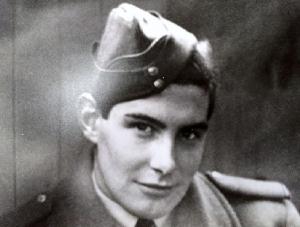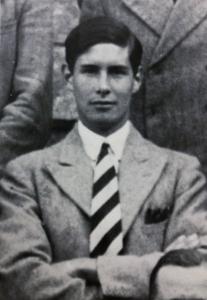
|

|
| Flight Lieutenant Arthur Richard Hugh BEAUMAN (39207) DFC | |
|
22 Squadron Royal Air Force Date of birth: 28th February 1918 Date of death: 5th December 1940 Killed in action aged 22 Commemorated on the Runnymede Memorial Panel 4 |

|
| Arthur Richard "Dick" Hugh Beauman was born at Penang in the Federated Malay States on the 28th of February 1918 the only child of J.C. Beauman and Dorothy Ann Beauman of 82 Gloucester Place, London. He was educated at Lancing College where he was in Heads House from January 1932 to July 1935. He was a member of the Boxing Team in 1933 and, on leaving school, he went on to Wye Agricultural College. He was commissioned as an Acting Pilot Officer in the Royal Air Force Reserve of Officers on a short service commission on the 19th of October 1936 and was posted to the Royal Air Force Depot at Uxbridge. On the 31st of October 1936 he was posted to No. 9 Flying School at Thornaby. On the 30th of June 1937 he was posted to RAF Gosport and was confirmed in the rank of Pilot Officer on the 24th of August 1937. In early 1939 he was married to Joan G. (nee Stammers) at Paddington in London; they had a son, Nicholas P.J. Beauman born in early 1940. He was promoted to Flying Officer on the 24th of March 1939 and to Acting Flight Lieutenant on the 15th of May 1939 but relinquished the acting rank on the 14th of July. On the outbreak of war he was serving with 22 Squadron based at RAF Thorney Island operating Beaufort aircraft in a torpedo bomber role. From February 1940 they began training in low level attack techniques before relocating on the 8th of April 1940 to RAF North Coates when they began operations. They were grounded in May when problems were discovered in the Beaufort engines. After a court of enquiry and modifications to the troublesome engines they resumed operations again on the 31st of August 1940. Initially they operated in a traditional bombing and mine laying role with attacks on the harbours of Flushing, Ostend, Calais and Boulogne. He was promoted to Flight Lieutenant on the 3rd of September 1940. On the 11th of September 1940 they set out on their first torpedo action of the war when a convoy of three enemy merchantmen was sighted at 2.30pm that afternoon off Calais. Five aircraft, led by Dick Beauman, set off for the attack and were supposed to pick up a fighter aircraft over Detling in Kent but, when this failed to materialize, Beauman decided to set out for the target anyway. When the formation arrived at Calais there was no sign of the convoy and he decided to sweep to the north east and the convoy was found to the south west of Ostend. The Beauforts attacked independently but three of their torpedoes failed to explode. Beauman and another aircraft then attacked, with one of their torpedoes hitting a 6,000 ton merchant vessel. On the 15th of September 1940 the squadron set out on its first "Rover" operation which was to become their standard method of operation over the coming months. This involved flying over the enemy coast seeking targets of opportunity in the coastal shipping lanes. This method of operation particularly suited Dick Beauman who was described by the author, Ralph Barker, as follows:- "Beauman had all the attributes of the popular hero—dashing, reckless, good looking, a trifle spoilt, accustomed to success, determined and fearless. He loved his role of lone wolf, was never happier than when he was searching off the Dutch coast, well inside visibility distance, often over the coast itself, prying into Dutch ports, seeking out the enemy. Married to a beautiful girl, with a young son, he had everything in the world a man could wish for. But he was headstrong and impatient; sinking ships was his job and his life, and he wanted to sink one every day. He was far and away the outstanding pilot of the Rover period, and he set a pace which could not but result in a rare competitive spirit on the squadron. If Beauman had a weakness it was his impetuousness. He always wanted results, and he loved the spectacular. Once, on a visit to Coastal Command Headquarters, he was shown a reconnaissance photograph of the "Bremen" and the "Europa" in Bremerhaven, surrounded by protective barges and torpedo nets. From that time on his mind repeatedly strayed northwards towards Bremerhaven, and more often than not on a Rover he strayed towards that area physically too. He drew plans of the estuary, showing how a torpedo might be dropped, and one night, on a moonlight Rover, he penetrated the harbour. Caught in a vortex of fire and blinded by searchlights he held on until suddenly he saw the anchored "Bremen" and "Europa" rush lopsidedly into his windscreen. To make a torpedo run was impossible, and he had to turn and climb steeply to avoid ramming the ships. Back at base, the other senior pilots tried to dissuade Beauman from making any further attempt against these ships, urging that it was not only suicidal but impracticable. But still Beauman hankered after them." On one occasion, when on a Rover patrol with fellow pilot Patrick Gibbs, they flew tight to the low cloud as they headed for the Dutch coast. Beauman sighted a number of ships including an enemy tanker of around 2,000 tons protected by three flak ships. He waggled his wings to signal that he was going into the attack, streaked across the water towards the tanker and released his torpedo. Such was the surprise he had achieved not a single shot was fired at him by the escorts but when Gibbs' attacked his aircraft received heavy fire and was damaged but flyable. Beauman's torpedo hit the tanker causing a massive fire, following which the ship sank. The squadron spent some time carrying out high level bombing attacks on Brest and on enemy airfields in France before returning to Rover operations. He was awarded the Distinguished Flying Cross on the 20th of November 1940 and the citation read:- "This officer consistently displayed determination and devotion to duty of a high order, especially when the squadron was suffering losses. He completed thirty six operations involving bombing and torpedo attacks and mine laying, often in adverse weather conditions and in the face of considerable enemy opposition. His keenness to engage the enemy at all times was exceptional." On the 28th of November 1940 Dick Beauman took off for a Rover Patrol along with Patrick Gibbs, making landfall at Texel. As Beauman searched the coastal shipping lanes, Gibbs was forced to turn back with engine trouble leaving Beauman to carry on alone. At the mouth of the Elbe Beauman sighted a large enemy convoy at anchor and, diving in, he released a torpedo which struck a 7,600 ton tanker causing it to catch fire and sink. He flew alongside the sinking vessel to read its name while his navigator photographed the burning vessel. The news of the sinking was broadcast on the BBC 9 o'clock news that evening and it was arranged that Beauman would give a talk on torpedo operations to the Home Service of the BBC on the 9th of December. On the 30th of November he was airborne again and made landfall at Den Halder before beginning his patrol. Shortly before midday he sighted a convoy of 15 vessels off Terschelling. He attacked but his torpedo went straight to bottom of the sea and he returned to North Coates very frustrated. He had radioed ahead to base and two other aircraft were scrambled to attack the convoy and one of the pilots, Patrick Gibbs, passed through thick flak to sink an enemy vessel. An hour after Gibbs had taken off Beauman again took to the air, rearmed and returned to have another attempt at the convoy. In the event his torpedo missed its target and he returned again to North Coates. On the 3rd of December Beauman attacked a 5,000 ton merchantman off Terschelling without result. By this time Dick Beauman had completed more than fifty operational missions in six months without a break. On the 5th of December 1940 Dick Beauman and his crew took off in at 6.45am from RAF North Coates in Lincolnshire in Beaufort Mark 1 L9936 OA-B for a Rover patrol off the coast of Germany in formation with two other aircraft from the squadron. They became separated during the mission with one of the other aircraft making an unsuccessful attack on an enemy vessel. On their way back to base, at about 9am, the crew of one of the returning aircraft, OA-I, saw a Beaufort crossing the estuary near Wilhelmshaven making for the harbour in an easterly direction. The Beaufort was seen to be under heavy fire from shore batteries and was about 400 feet above the water, but was still armed with its torpedo. It was Dick Beauman’s aircraft which was never seen again and was later reported by German radio as having been shot down. The crew was:- Flight Lieutenant Arthur Richard Hugh Beauman DFC (Pilot) Pilot Officer Patrick Herbert Telford Sergeant Terance John James Pilot Officer Frank Wade Hicks There was speculation among his fellow pilots that the temptation to attack the well defended "Bremen" and "Europa" in the harbour had been too great for him. His wife received the following letter dated the 7th of December 1940: - "Madam, I am commanded by the Air Council to express to you their great regret on learning that your husband, Flight Lieutenant Arthur Richard Beauman, Royal Air Force, is missing as the result of air operations on 5th December 1940. I am to explain that this does not necessarily mean that he is killed or wounded and if he is a prisoner of war he should be able to communicate with you in due course. Meanwhile enquiries will be made through the International Red Cross Society, and as soon as any definite news is received, you will be immediately informed. In the event of any information regarding your husband being received by you from any source it would be appreciated if you would kindly communicate it immediately to the Air Ministry. The Air Council desire me to express their sincere sympathy with you in your present anxiety." A further communication dated the 24th of September 1941 stated: - "The aircraft was last seen in the vicinity of Wilhelmshaven where heavy anti aircraft fire had been experienced, and it can only be concluded that his machine was shot down by this fire." He was mentioned in the Air Ministry's despatches of the 17th of March 1941. His widow was remarried to Charles Skarratt in 1942. He is commemorated on the Wye Agricultural College Memorial and on Panel 1 of the RAF North Coates Memorial in the foyer of the Town Hall at Cleethorpes in Lincolnshire. |
|
 | |
| Heads House |
Back